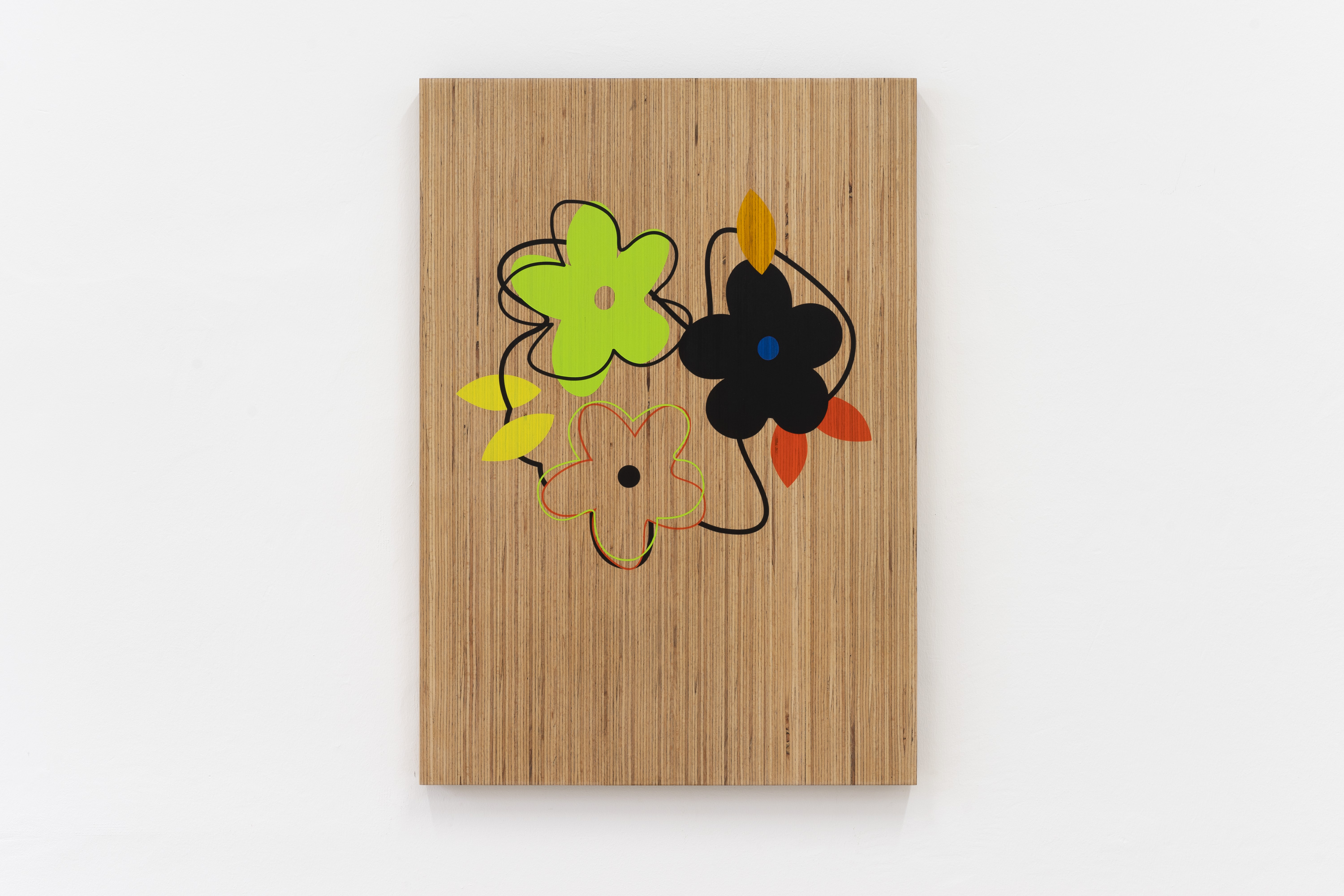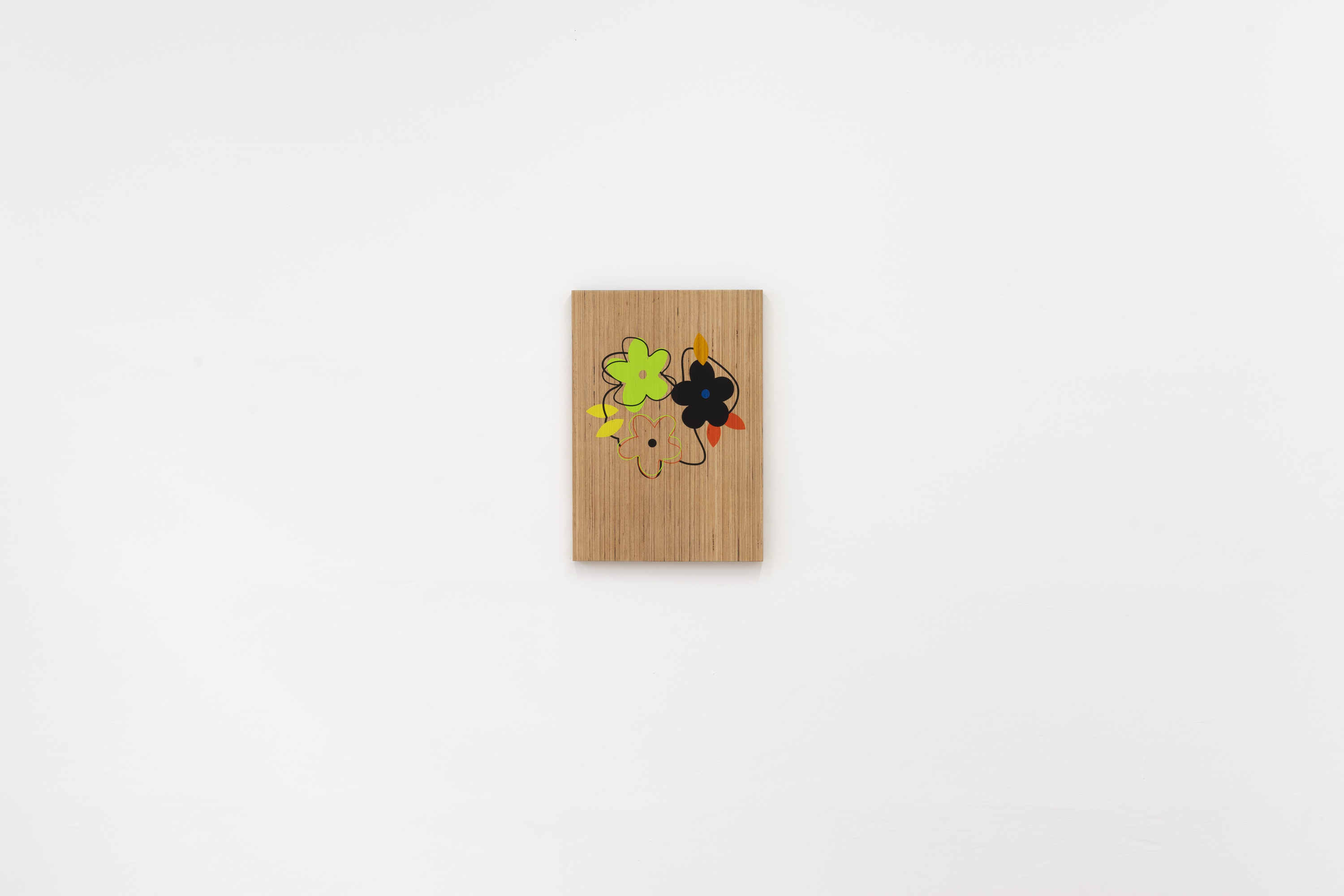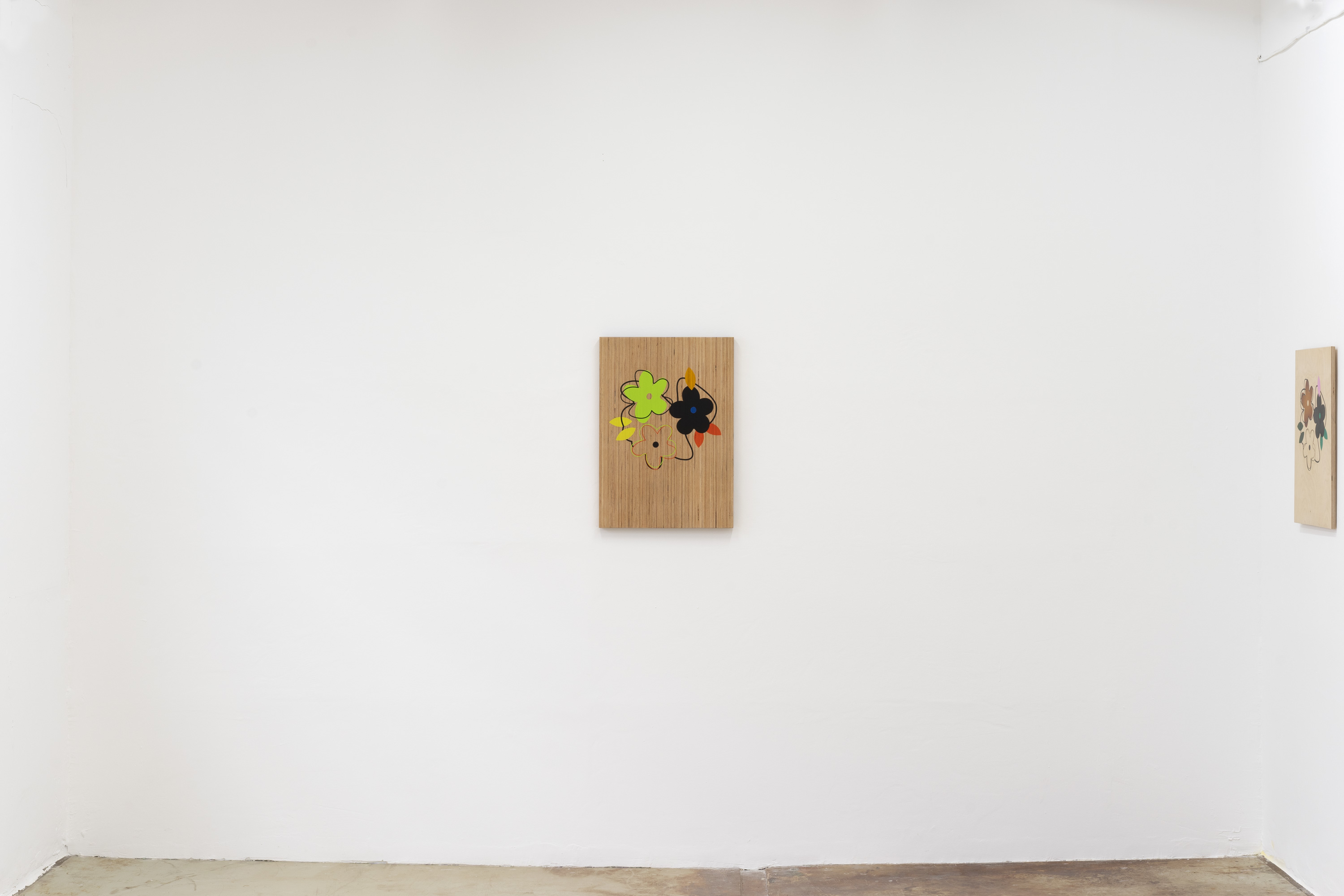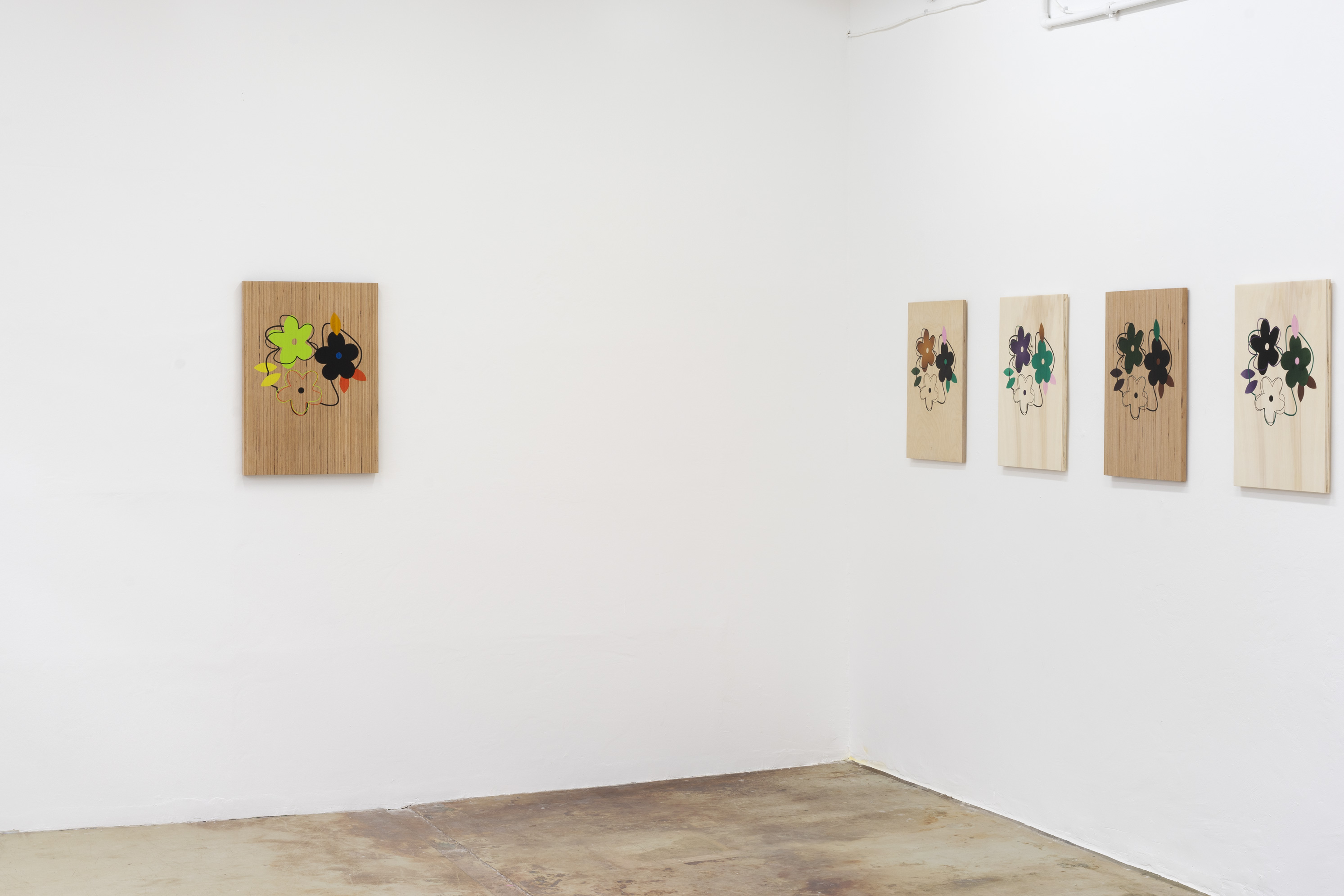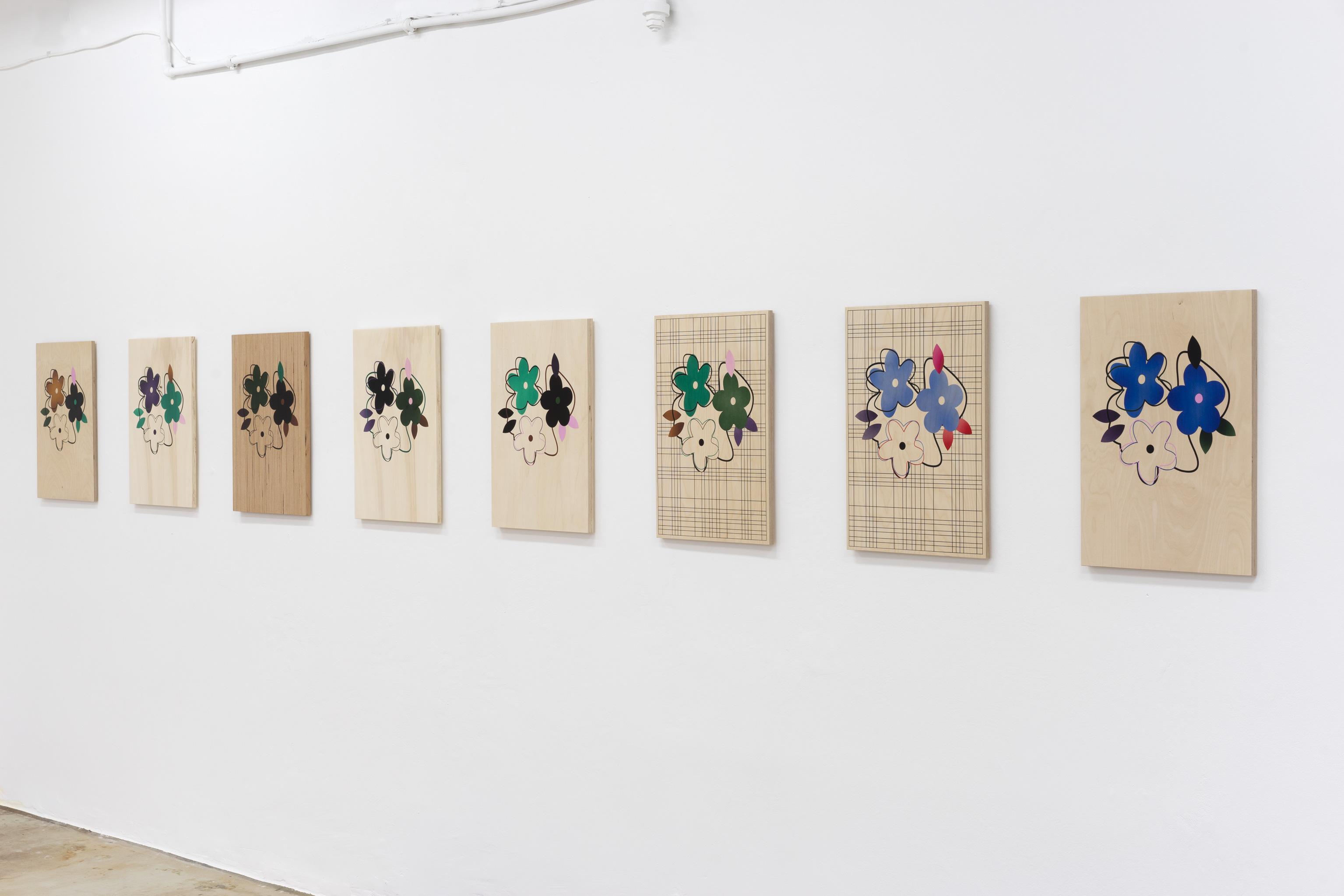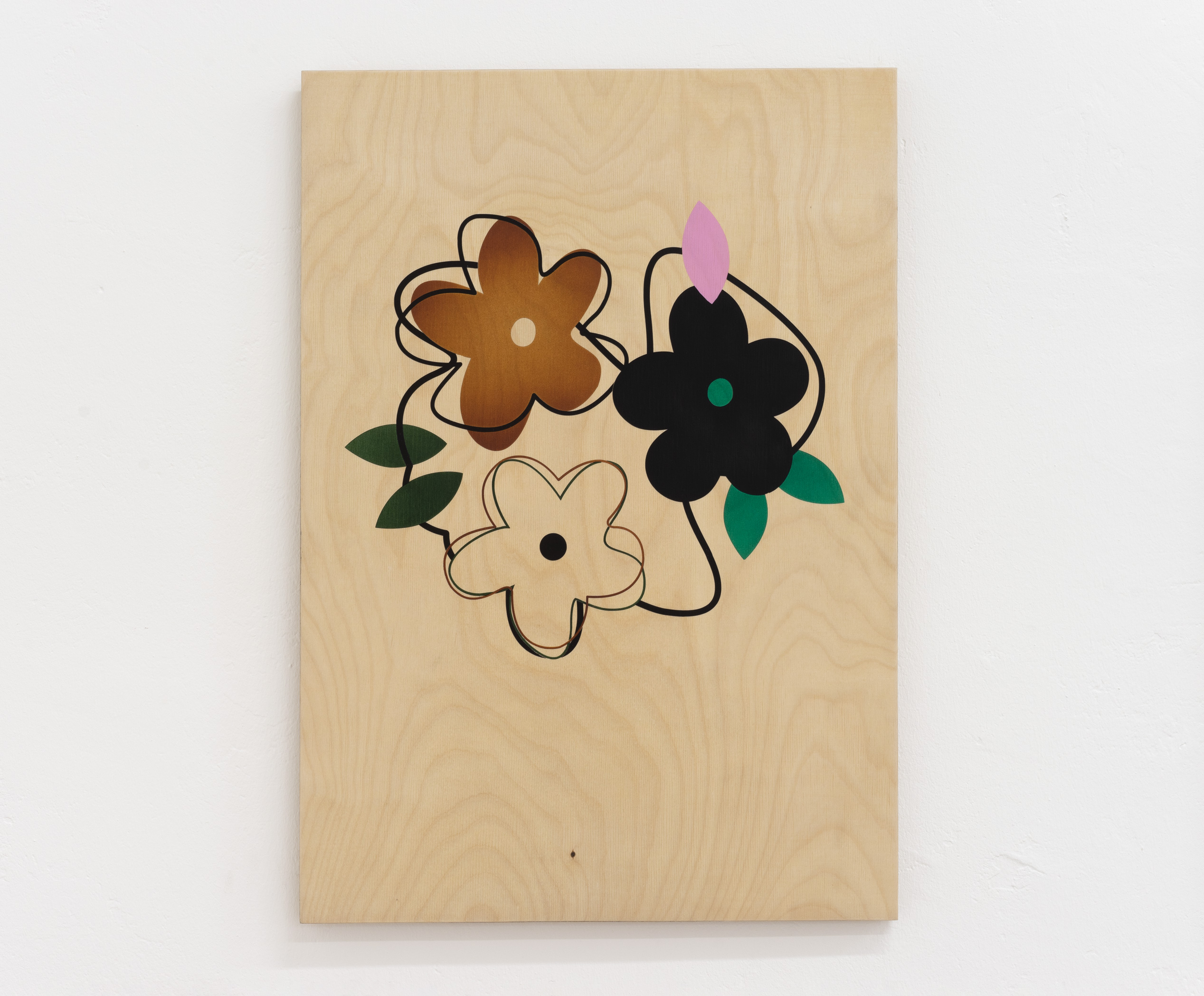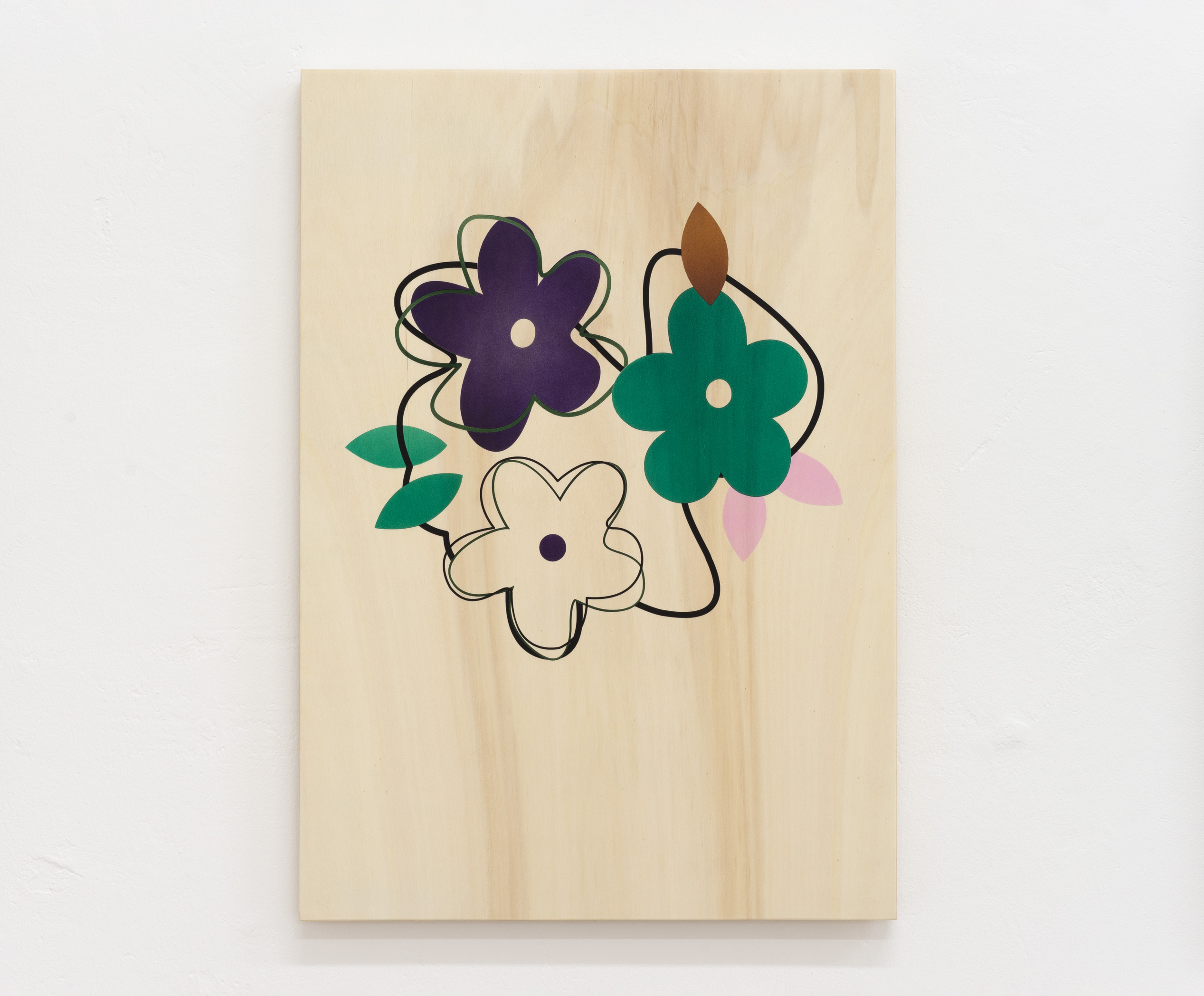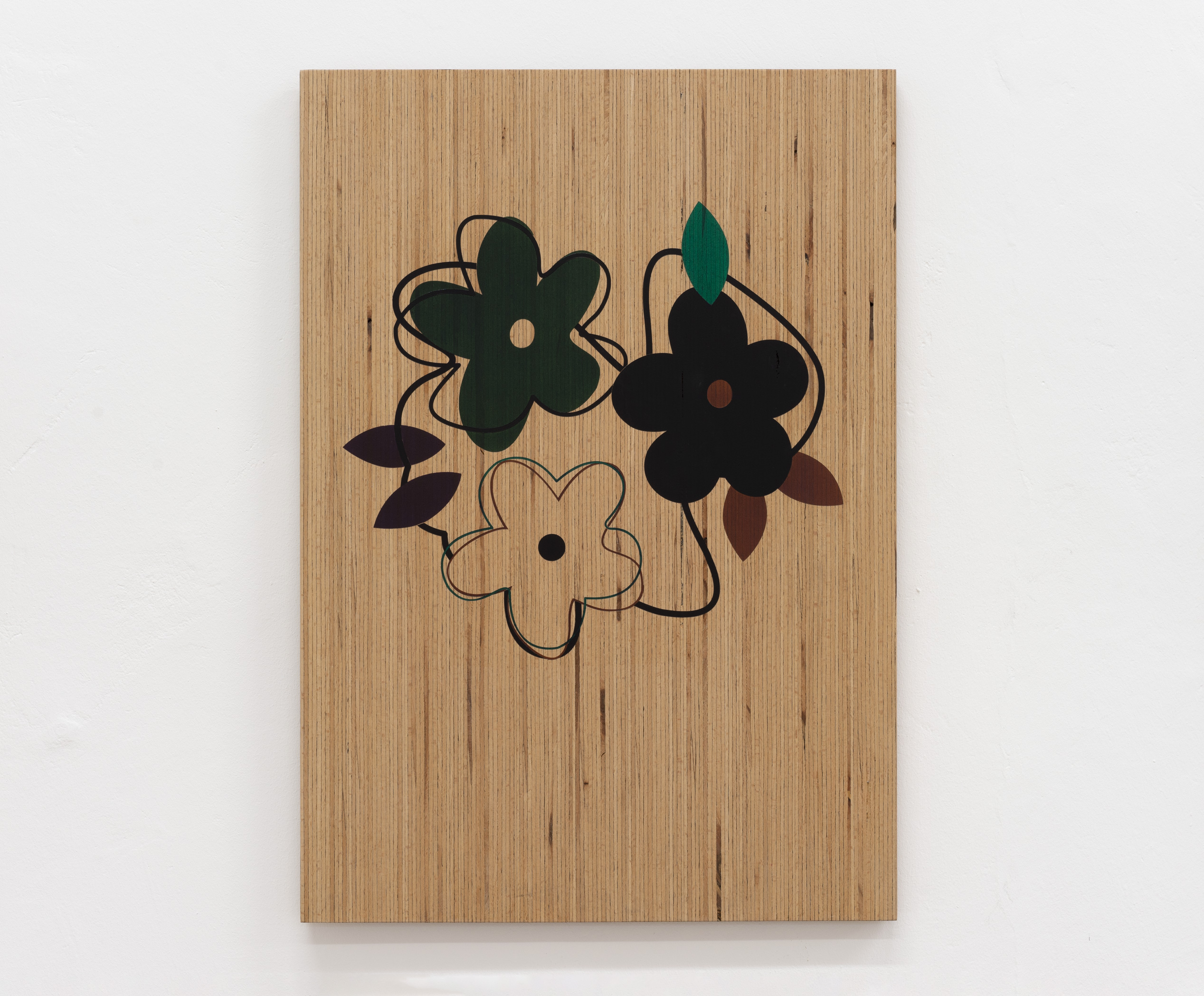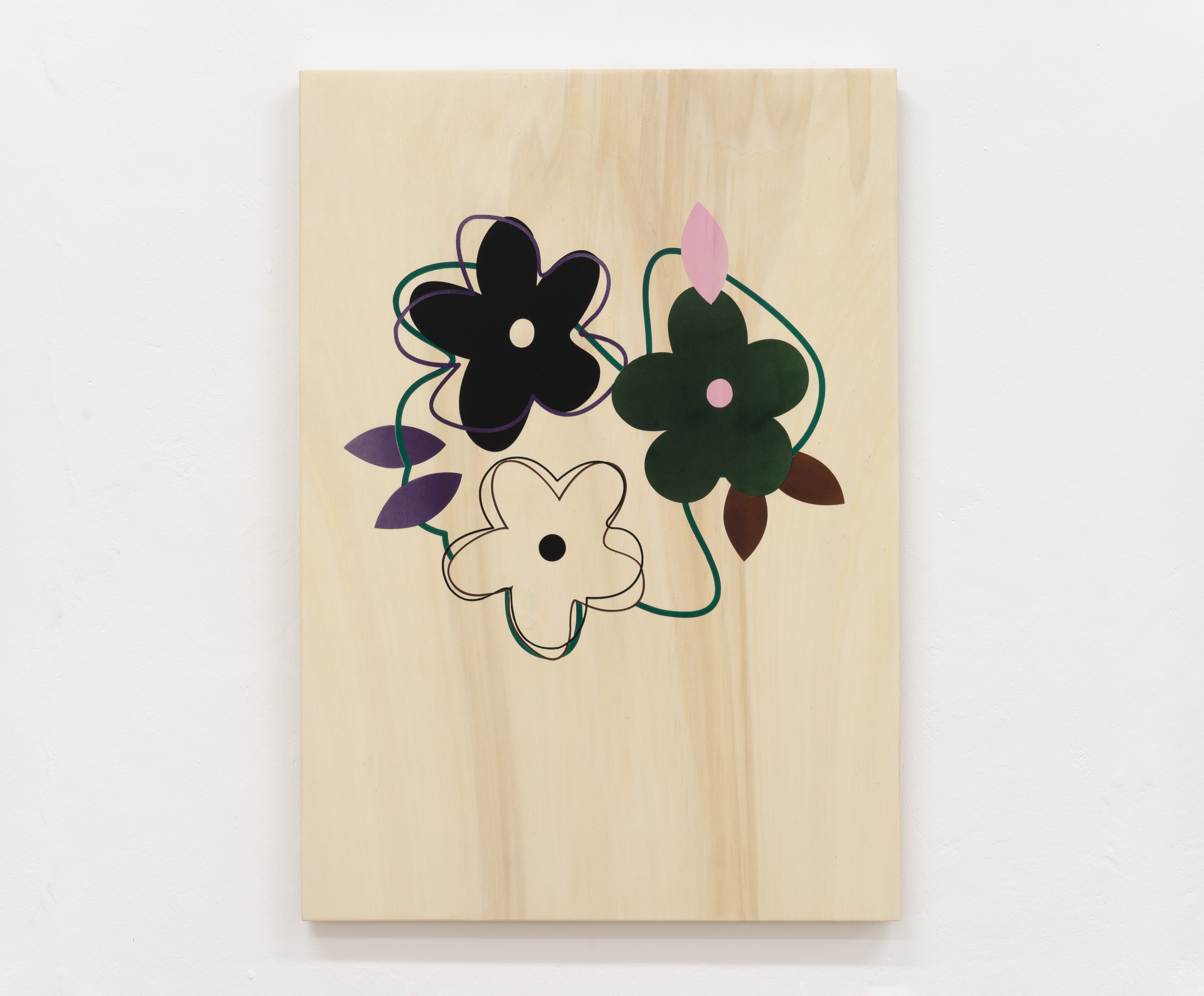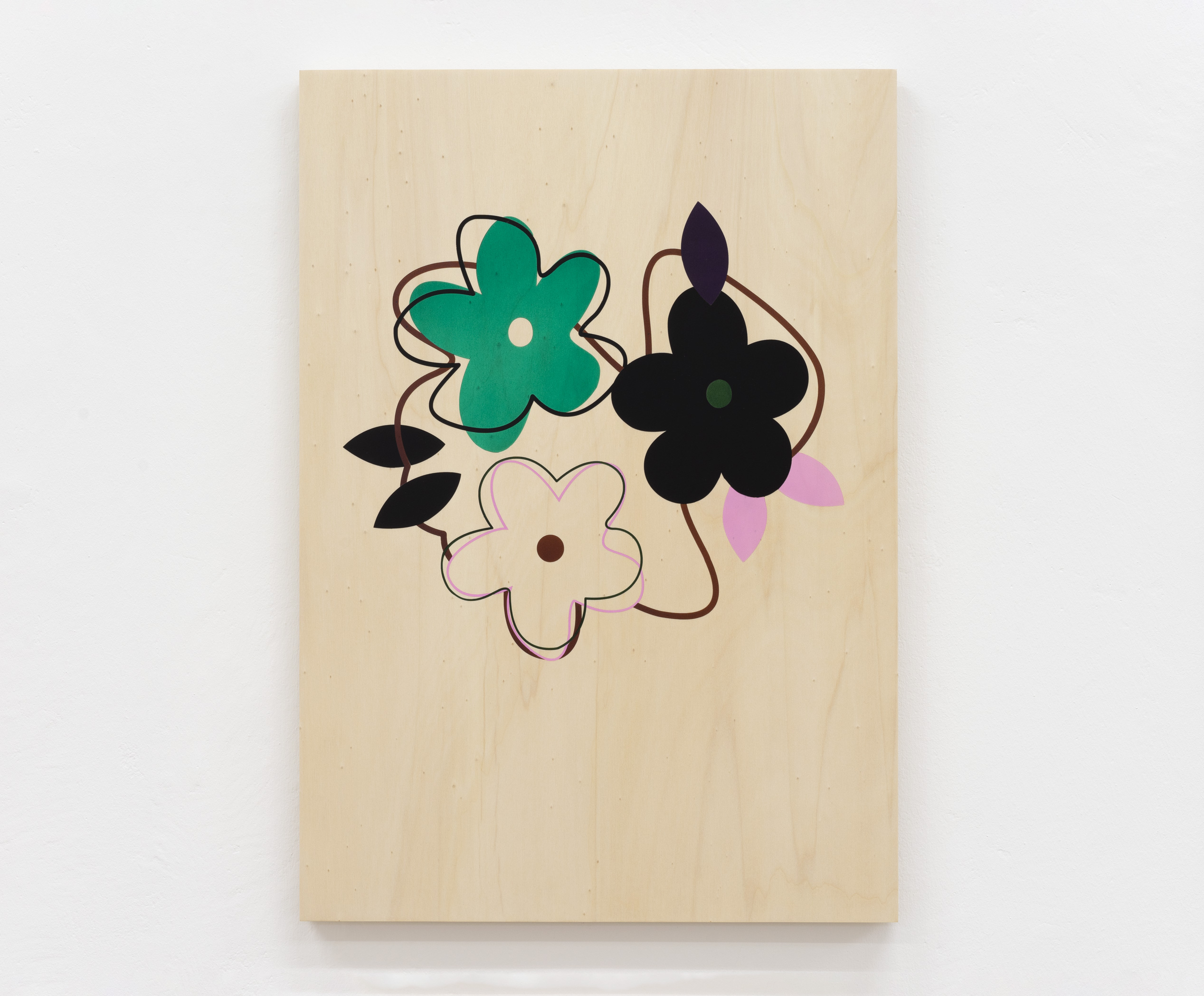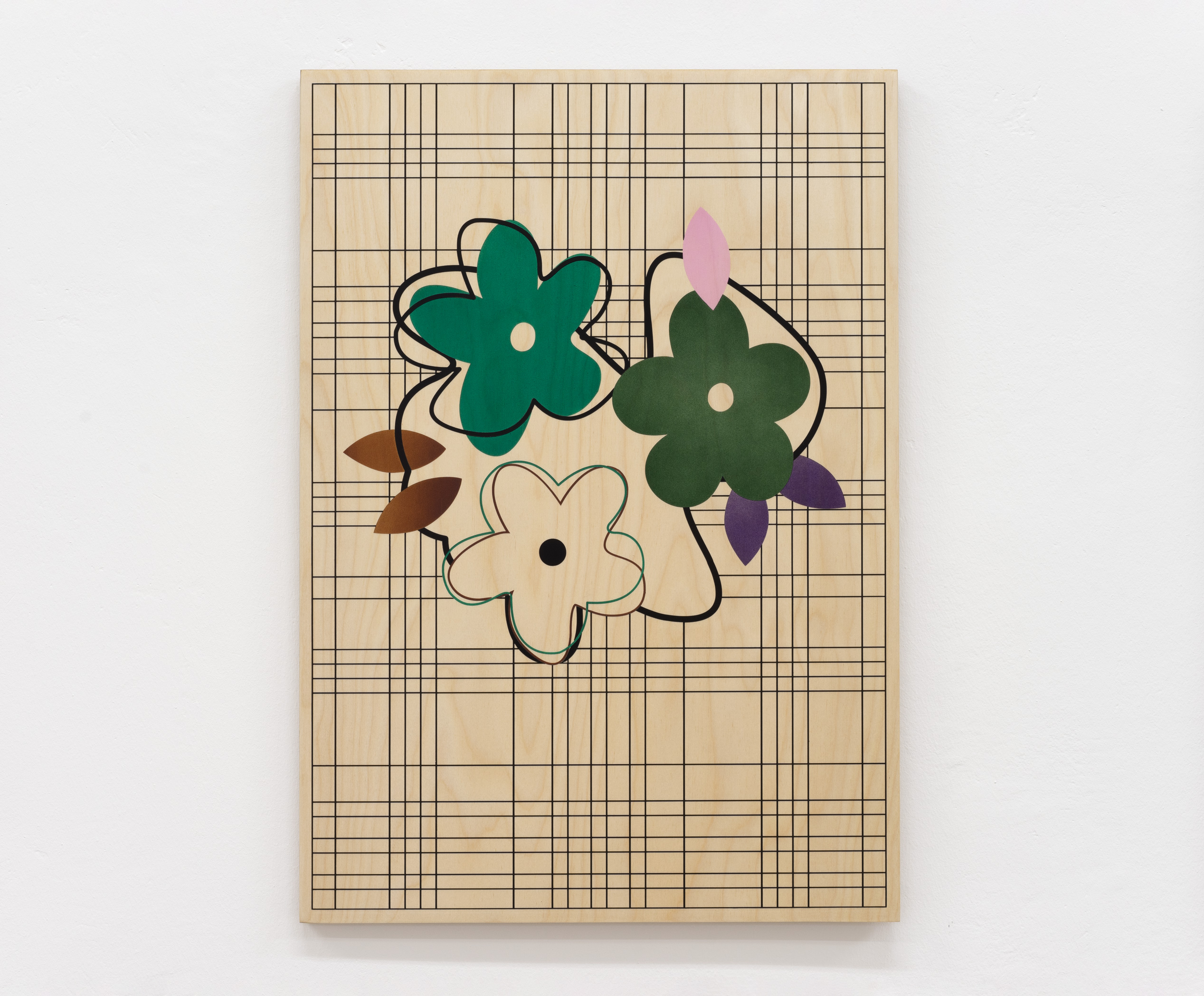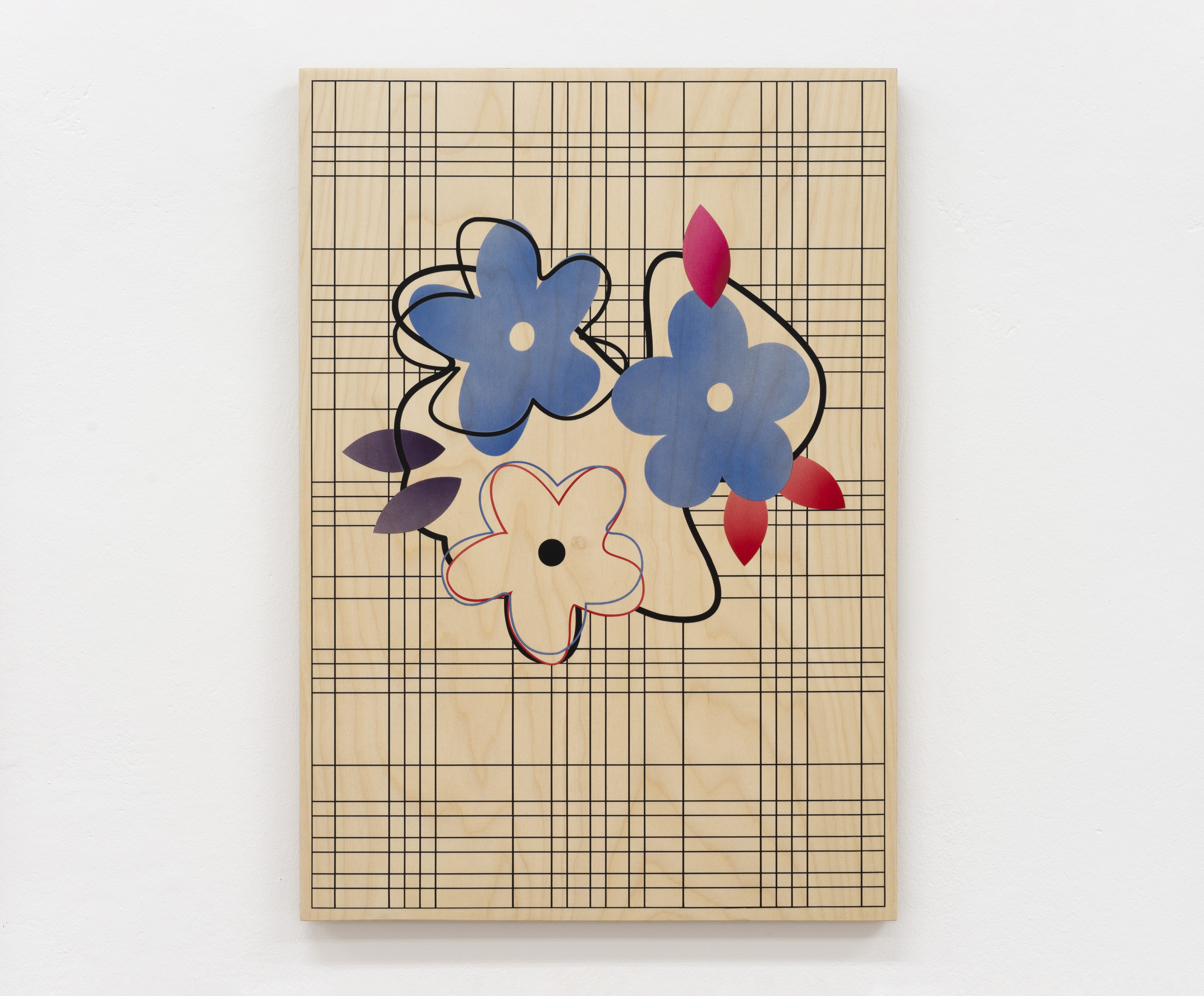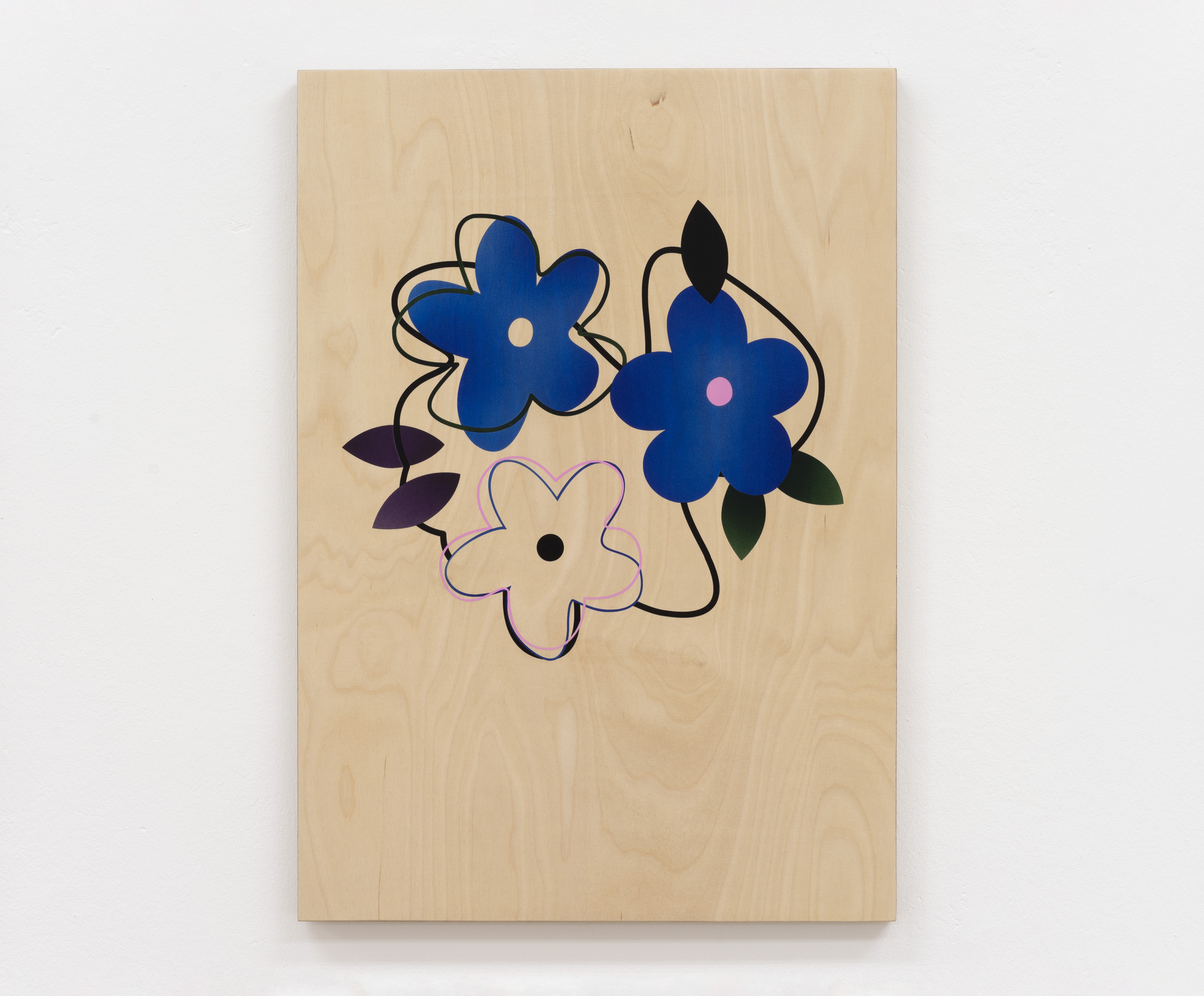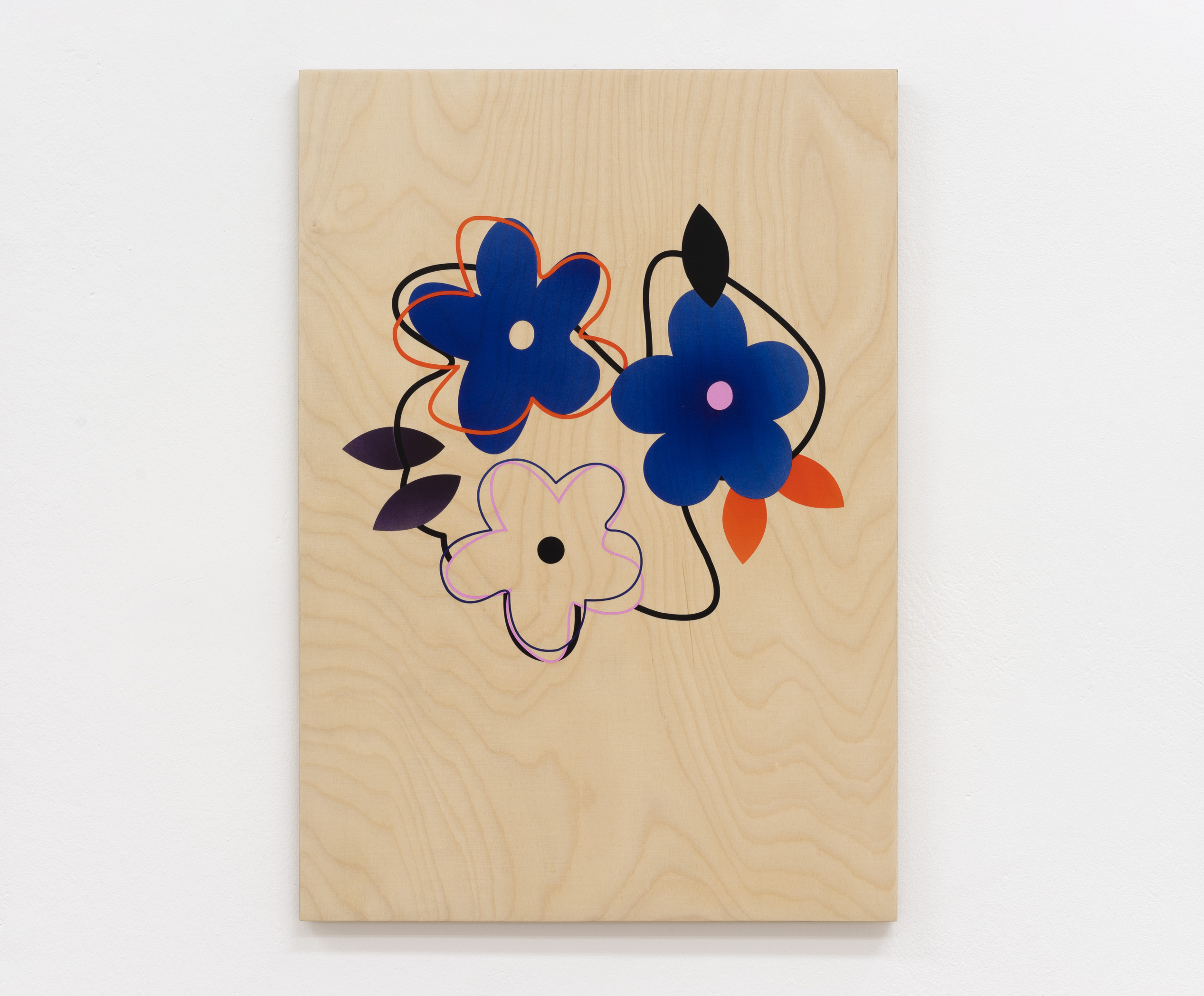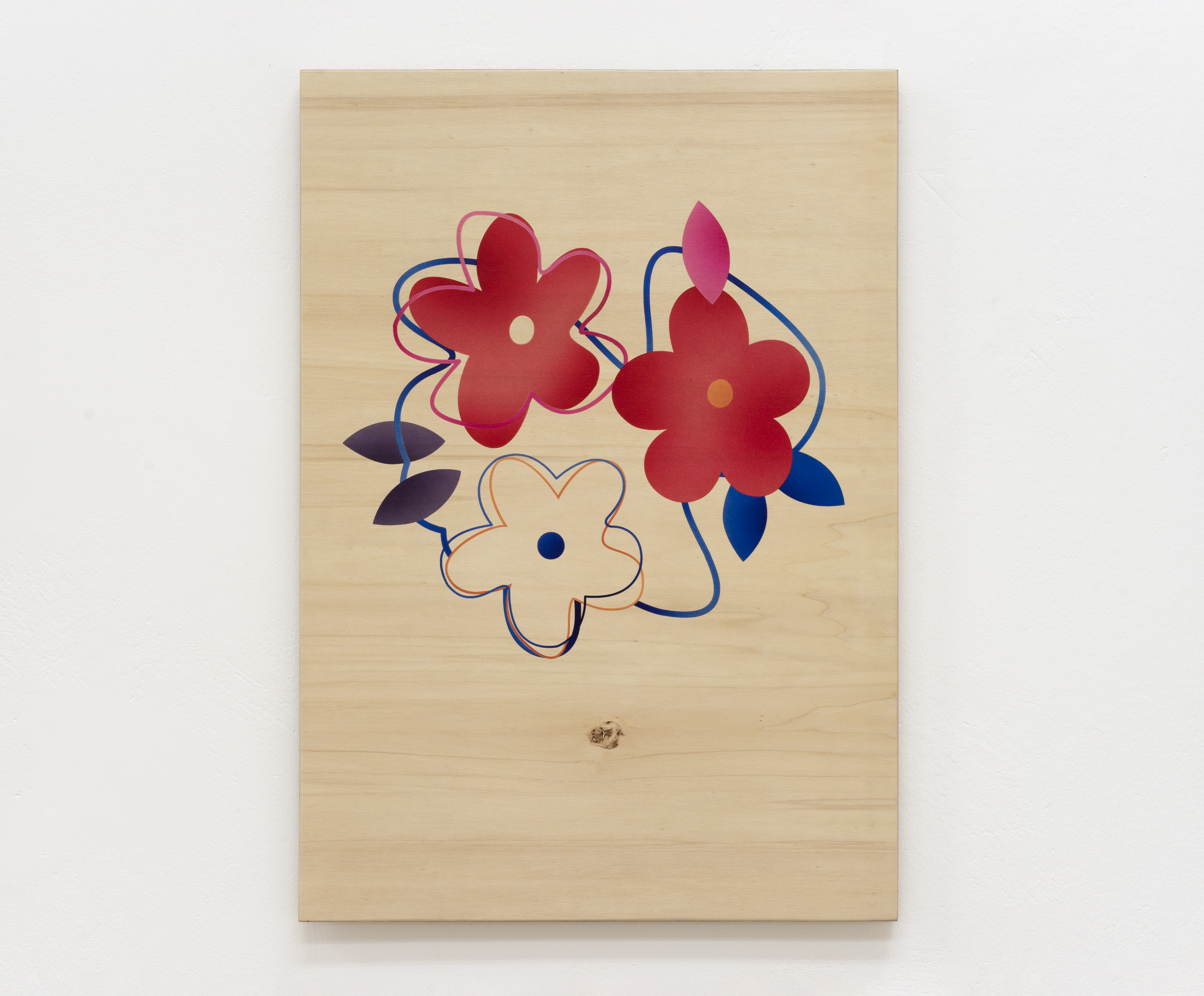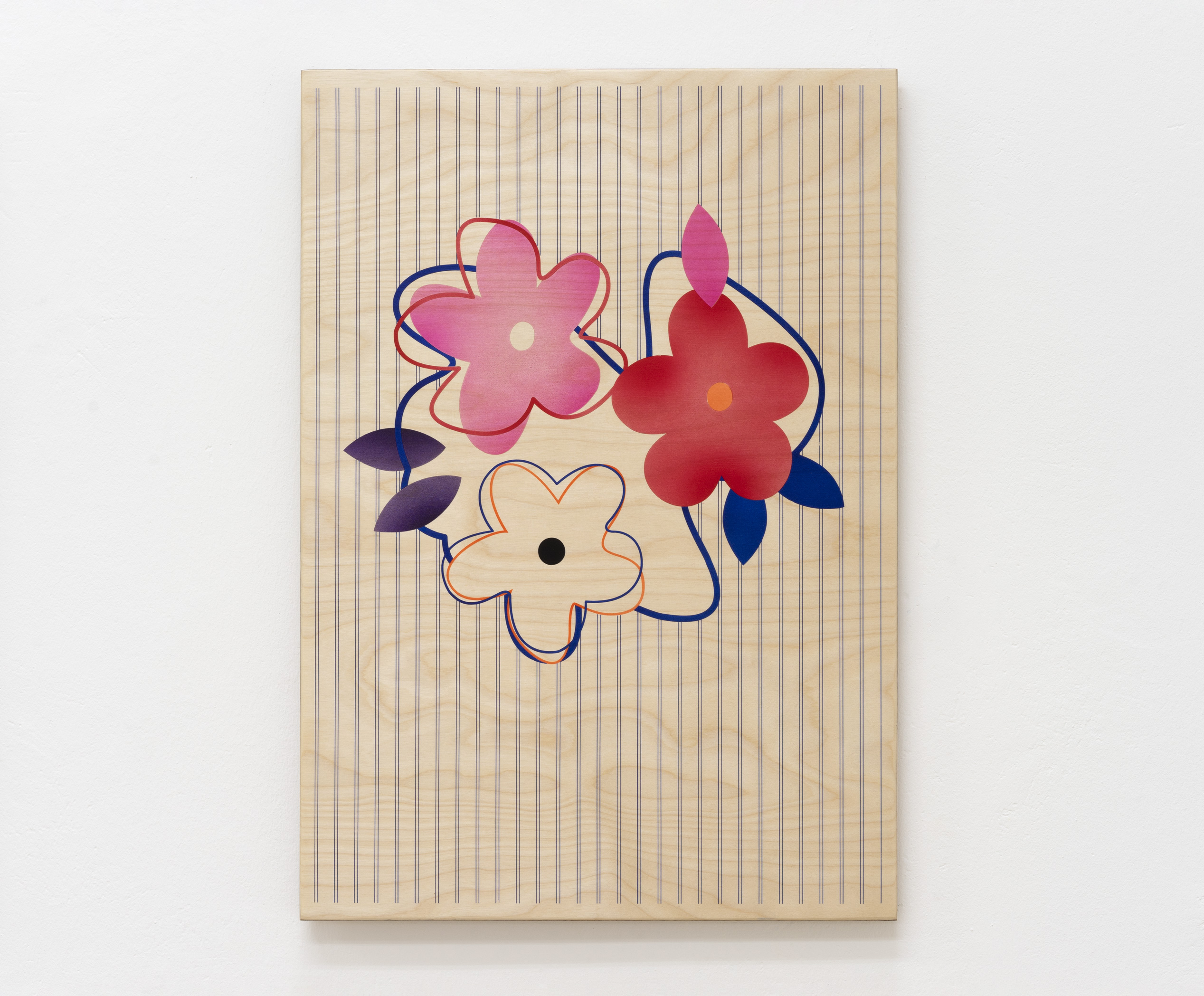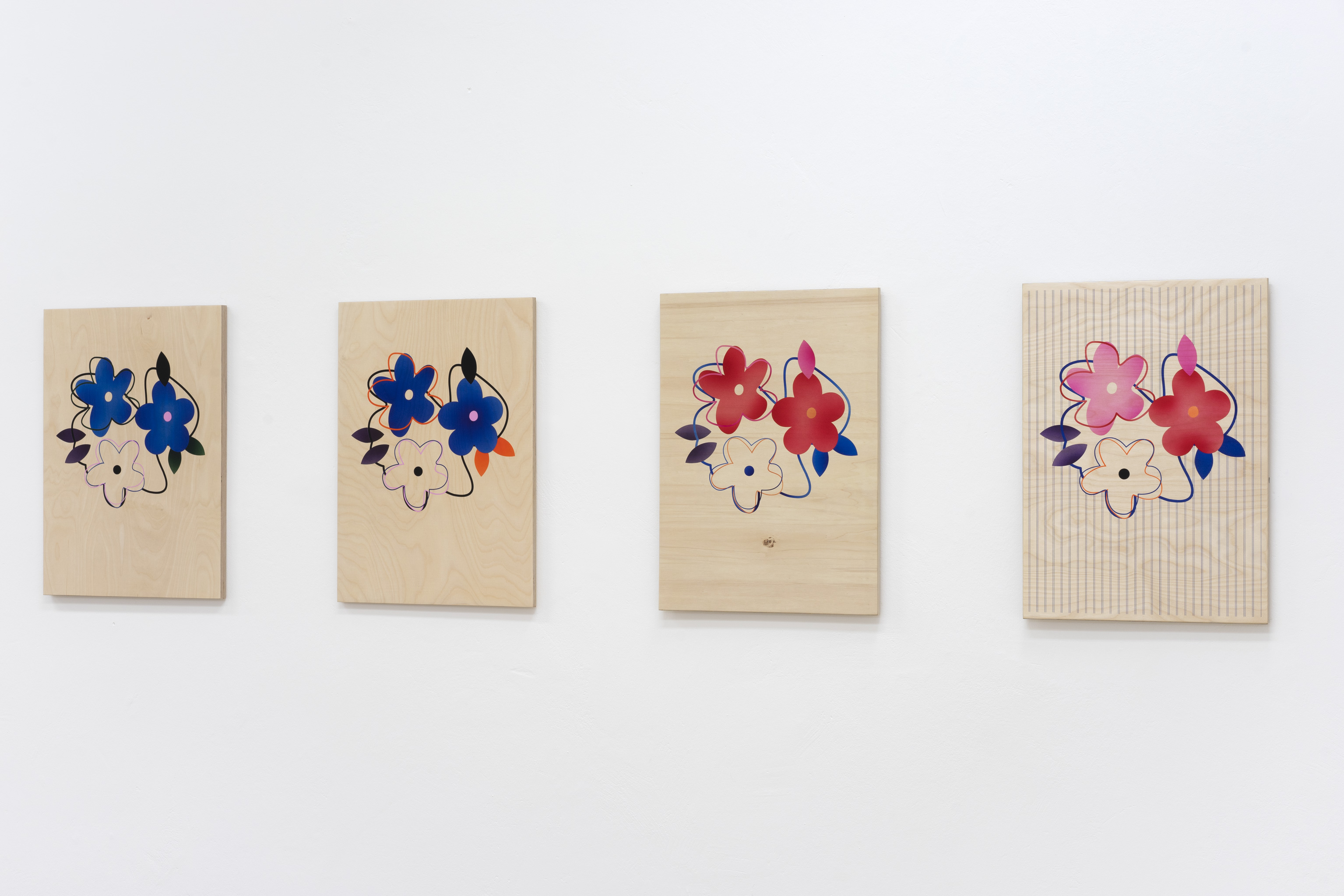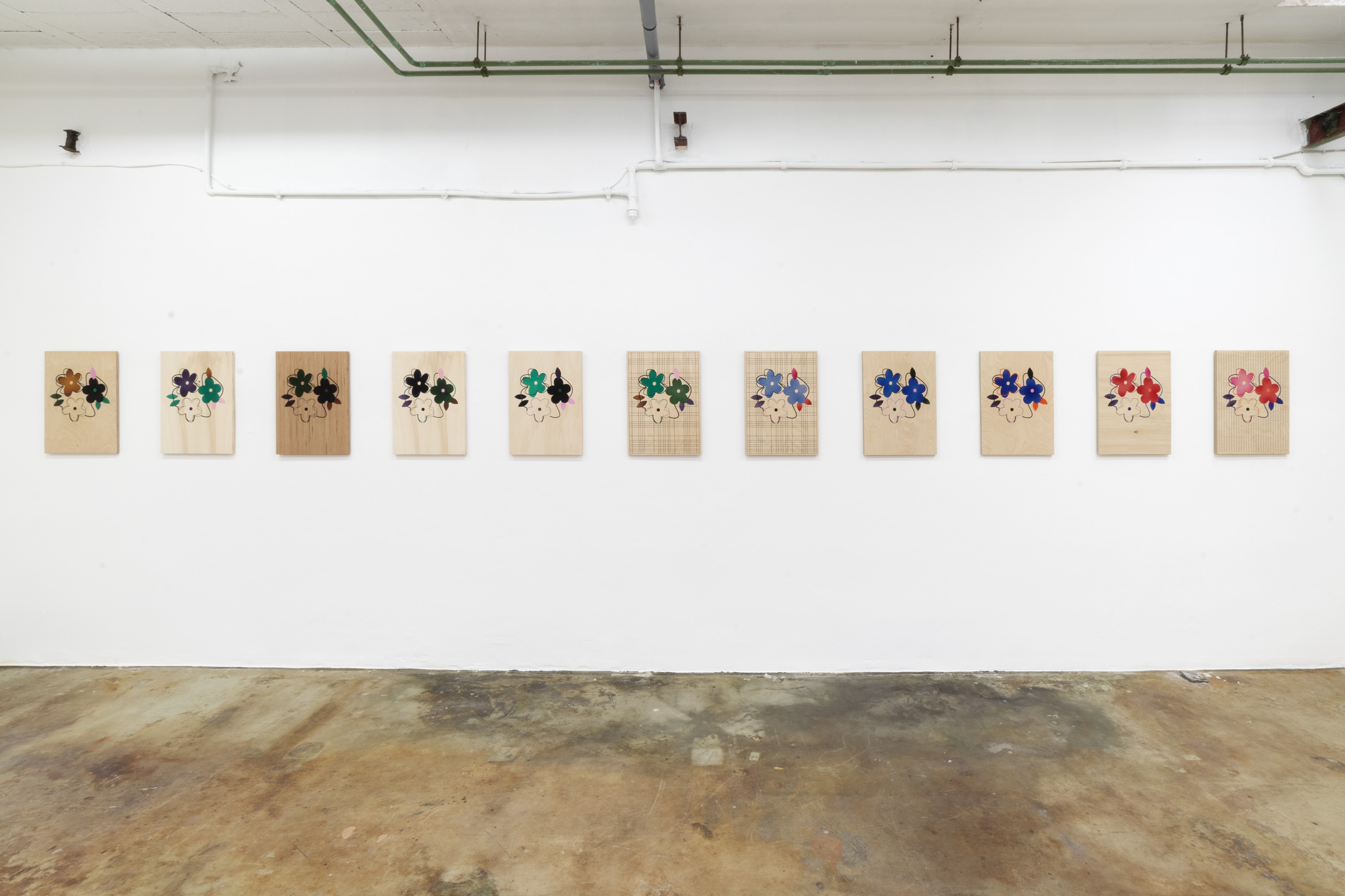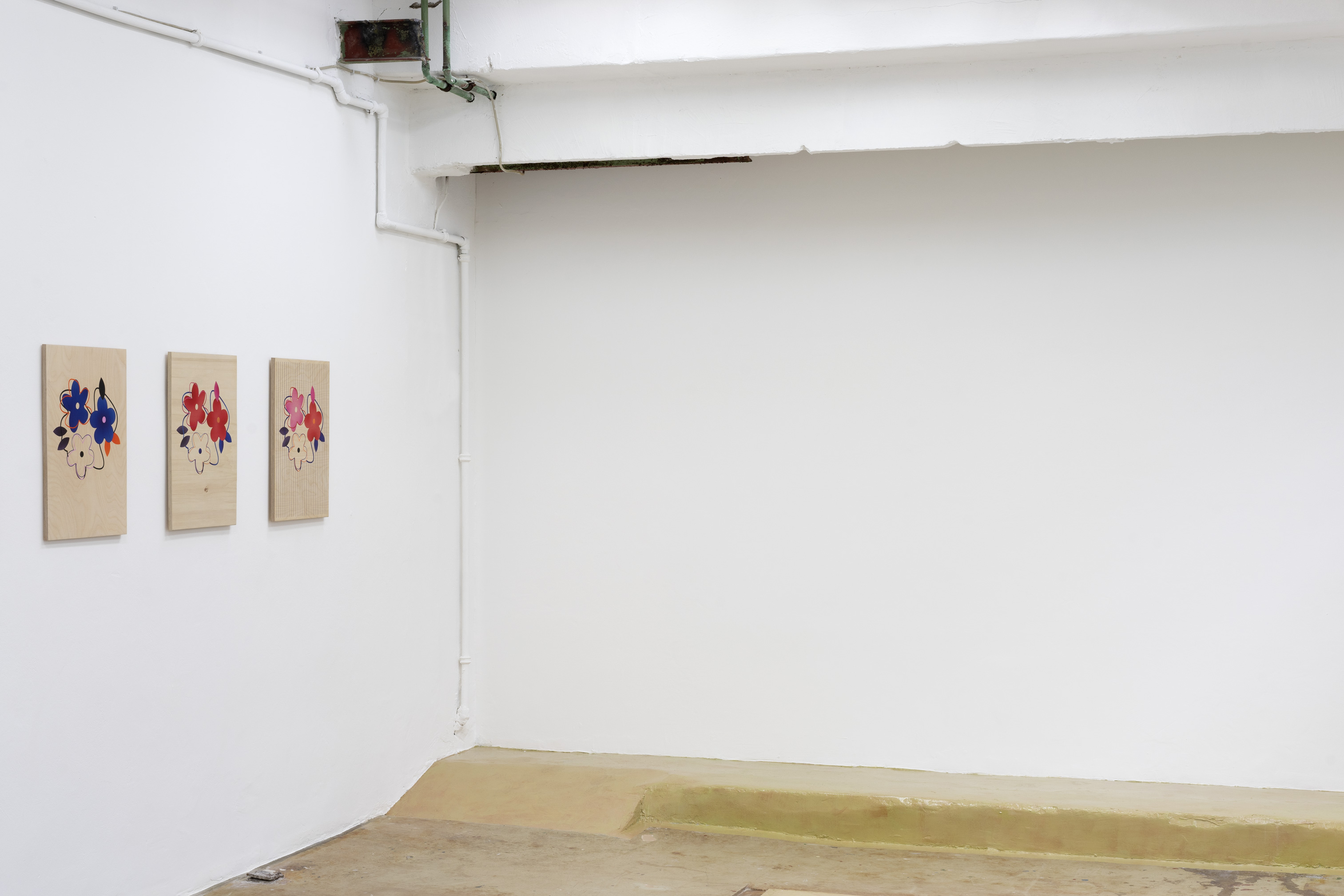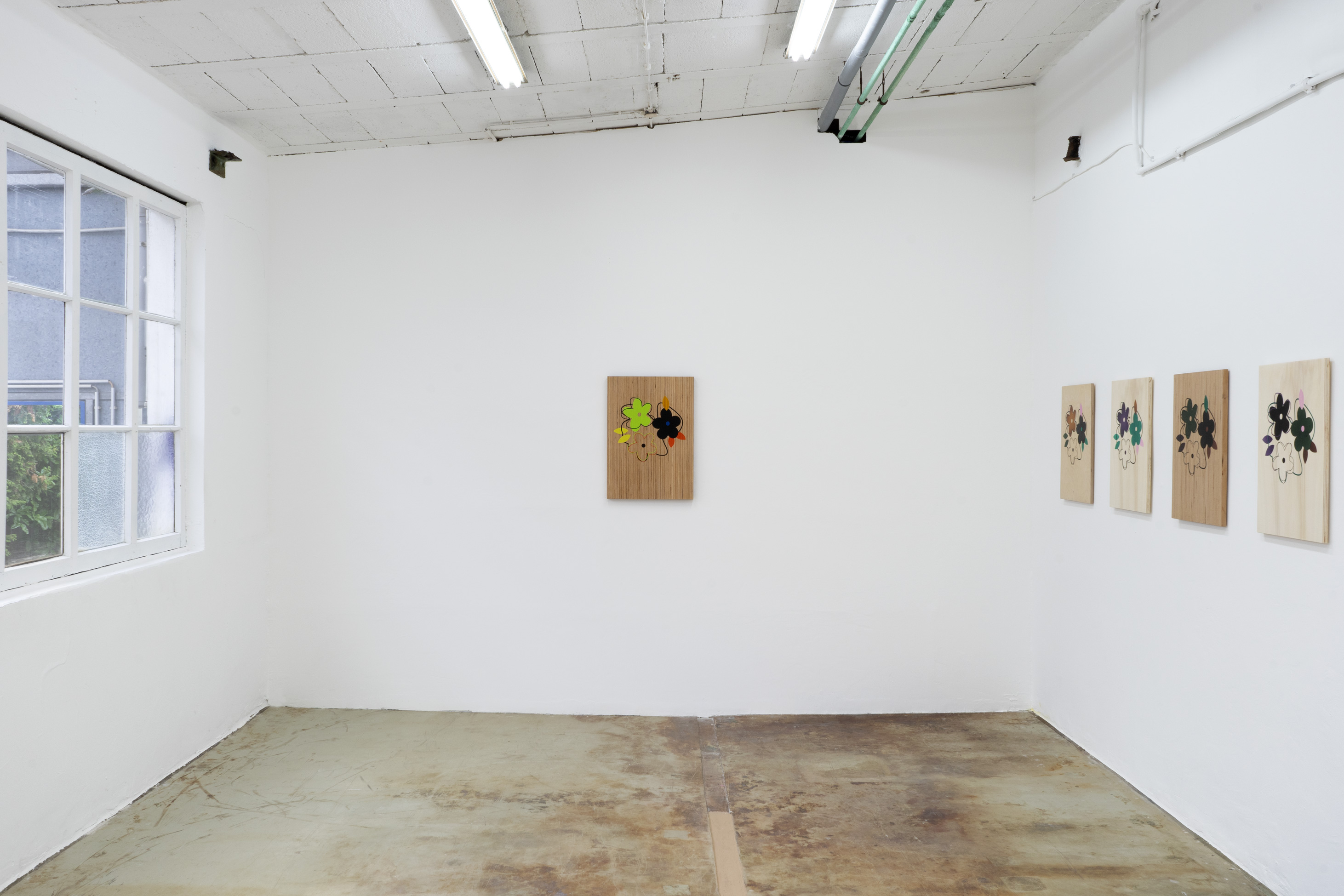Soft Skills
Soft skills
Noémie Bablet
July 01 2023 - August 05 2023
If you are not familiar with the world of finance or business, here is first a definition of soft skills. As opposed to hard skills, which include the skills you learn to do a job (learning to code for a computer scientist or medical studies for a pediatrician), soft skills refer to a set of skills that could be described as human or relational: the ability to adapt, communicate and work in a team, creativity, a positive attitude, ethics, but also the resolution of crises, and the ability to make concessions. The addition of hard and soft skills — as you may have understood by now — provides the ideal profile of a worker and promises optimal efficiency for the company.
For her solo exhibition at wieoftnoch, Noémie Bablet presents a set of acrylic paintings on wood featuring an identical motif composed of three flowers, five leaves, and a stem or line softly and roundly framing the whole.One would be tempted to assign this elastic-looking motif to an outdated domestic design or to the world of cartoons, and to qualify the presence of the flowers and the rather flexible plastic aspect of the painted image as soft.
On most of the panels, thick as frames, the design keeps the same proportions, and the color of the elements that compose it is declined using the same color chart, rather harmonious, of greens, ocher, pink pale, purple and black. In other works, the color family is altered. The generic(1) representation of flowers stretches over a final panel to fit into a larger format, which is combined with a new, more acid color palette, made up of orange, apple greens, black and ochre.
The order in which the colors are painted, the appearance of a grid on what we would call, by default, the background — so much the smoothness of the airbrushed image seems to exists on the surface, and the variations of colors and texture due to the wood species used, offer a distinct visual rearrangement that is never repeated. The more or less strict rules of the game, which the artist imposes on herself, have been reduced to a minimum: a single and unique motif, to be declined according to a set of colors chosen on supports with various potentials. What remains then is the pleasure of the combinatorial challenge, the pleasure of making with the hands and making appear.
How many times can a new musical structure be constructed by using an existing creation but modifying the scale (the color palette) or by applying flats (a lighter version of the same color); by using a vibrato or a tremolo (a gradient); and by playing differently with the acoustics depending on the location (a wooden panel with more or less grain or knots); thus varying the listening of the spectators?If we follow the musical metaphor, this score (the floral motif) would certainly not be found in chamber music or jazz, even if Noémie Bablet creates her own drawings, but perhaps in concrete music(2) research and in industrial culture(3): new pieces based on the sampling of a (visual) noise society.
This drawing, like others previously imagined by the artist (Credits, Signs of excitement), is part of her vocabulary and her toolbox. It has already been used on earlier works that occasionally suffered less lenient treatments, sometimes frankly hardcore, such as extreme stretching, a stripping of elements or a thinning of the thickness of the lines. Experiments that test the elasticity of the plastic pattern. In this search for a rather artisanal serial production (the artist uses stencils of her drawings to produce the paintings here present), rearrangement and combinatorial pleasure, the motifs have already been found in the form of stickers in order to allow the creation of new compositions and their overflow into real space.
Noémie Bablet's flowers share the reproducible potential of Andy Warhol's Flowers, also declined in a multitude of chromatic experiments and multiplied serially, until they saturate the walls of the galleries where the paintings are exhibited. The image chosen — stolen(4) for Warhol — or researched and constructed — for Bablet — is so by its visual effectiveness. A simple, generic, harmless image even, in this case, which can be quickly read, and yet also plays on the sensitive or nostalgic chord of the viewer(5). Like Warhol, the world of advertising, and that of design and fashion, know something about the construction of an attractive image.
To think of an immediately apprehensible visual form, with which we feel identified, and which we want to possess through its freshness and novelty, is neither obvious nor easy. It is even rather hard as a challenge. The collaboration that Noémie Bablet led with Comme Des Garçons(6) seems to confirm the effectiveness of her ability to make her applied and intelligent research of a plastic form supporting its reproducibility, and a perfectionist technicality, wear the mask of simplicity and softness.
The subject of the painting is finally no longer so much what is shown to us, but the pictorial processing (aerial and on the surface) and its reception, since the game of possibilities seems to empty the image of its meaning and pull it towards abstraction. If Lily van der Stokker's acid flowers, one of the artist's key references, were able to arouse strong reactions(7) because they sowed a kind of silliness that undermined the virile conceptual and minimal artistic heritage of the 1970s, those of Noémie Bablet does not refer us, either, to a naive sweetness.
The oxymeric promise of the title is kept: it is not the ability to handle weapons that wins the war of images, but the ability to seduce the enemy(8), the eye that beholds.
Ana Mendoza Aldana
(1) By generic I mean that if I asked you to draw a flower, you would probably draw something similar. The mental image most of us have of the word “flower” may be closer to an hibiscus or a daisy than to a bird of paradise. It is this image that we have already seen and integrated to represent a flower.
(2) Concrete music is situated between a sound abstraction (absence of visible musical instruments played live) and the “palpable”, concrete rendering of this abstraction leading to new fictions created by the sounds you hear. Noémie Bablet's painting seems to operate towards the abstraction of a figurative motif through its repetition to take us beyond this figuration.
(3) Industrial culture,especially industrial music, was born in the wake of concrete music. It observes and criticizes the industrialization of the world. It sometimes employs the means of the mass media for its dissemination, yet applied to a rare production. Industrial music is distinguished by the use of samplers allowing the integration of repeated, altered and modified noises or sounds in order to create new musical compositions. I am thinking in particular of the experiences of Cabaret Voltaire or Throbbing Gristle.
(4) For his Flowers series (1964), which shortly precedes the invention of the expression “flower power”, Andy Warhol uses a photograph by Patricia Caulfield, which appeared in Modern Photography. This loan is not without consequences: Warhol is summoned to his first trial and must pay royalties on each painting to the photographer
(5) I mentioned above a somewhat outdated design, which could remind you of that of our parents' or grandparents' dishes, for example. These flowers also make me think of the seabed of Bikini Bottom or those used as the setting for films like Snow White or Bambi.
(6) Comme des Garçons uses the same pattern for its Fall Winter 2023 Girl Collection.
(7) “I was starting to get exhibitions and I was getting extreme, sometimes aggressive responses [...] Most of the work that I made then in those early years was all around the decorative, the flower, optimism and colour. [...] People did walk out of the exhibition [at Museum Fodor, Amsterdam, 1991] angry, and gave me the finger saying: “This is 1960s stuff”.” Hetti Judah, Lily van der Stokker, TP, n°18.
(8) If the concept of “softskills ”was born within the American army in the 1960s to qualify any skill apart from the handling of weapons, the concept of “soft power” developed by the political scientist Joseph Nye in Bound to Lead: The Changing Nature of American Power (1990) seeks to name the transformation of American power in the geopolitical landscape of the 1990s, post-Vietnam War. The United States, whose army remains strong, has perhaps won more conflicts thanks to the visual culture of Disney, McDonald's and Coca-Cola than thanks to its fighter jets.
